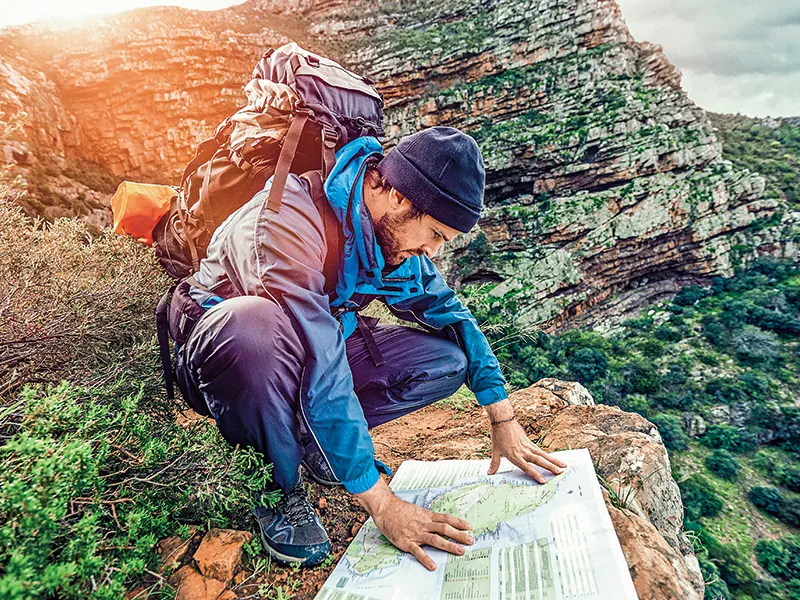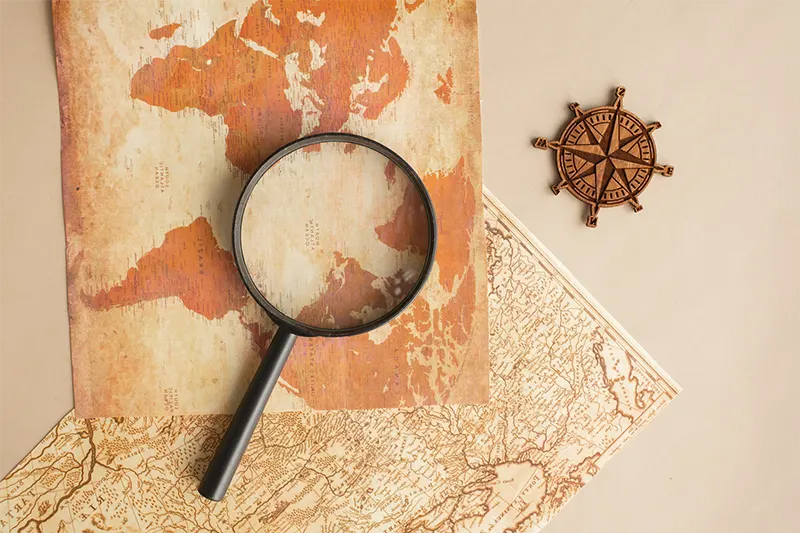Technology has made it a breeze to retrace our steps when we get lost. With GPS, you’ll be able to see every turn you have to take to get to your destination. But what if you don’t have access to one? Do you know how to read a road map?
The first step on how to read a road map correctly is knowing the symbols, like contour lines and legends. Then, pinpoint your current location and orient the map so it faces the same direction you are. After that, you can easily trace the best route and note down landmarks to make sure you’re going the right way.
Still confused? Below is a closer look at the five steps.
Quick Navigation
- 1. Familiarize Yourself with the Index, Legend, and Contour Lines
- 2. Orient the Map Using the Compass Rose
- 3. Choose the Best Route With the Map Scale
- 4. Keep An Eye Out for Landmarks
- 5. Practice, Practice, Practice!
- Lost? Here’s How to Get Back on Track
- Conclusion

1. Familiarize Yourself with the Index, Legend, and Contour Lines
Before anything else, let’s get to know these terms:
Index
The index shows the cities listed in alphabetical order. Beside the name of the city is the location code. The code basically tells you which part of the map the city is in based on a grid system. Across the y-axis, you may see letters, and down the x-axis could be numbers or vice versa.
For example, your current location is at City A. If you want to find its location on the map, you simply go to the index and look at its code. If, for example, City A is located at C5, then you can look at your map and pinpoint where Column C and Row 5 meet.
Map Legend
The map legend tells you the line style or color used for certain road types. Generally, most maps use thicker lines for major highways whereas less important streets use fainter, sometimes broken, lines. This helps you easily identify the direct route from one place to another.
The legend also includes other symbols and line types representing different areas. Mountains are marked with brown outlines, bodies of water in blue, forests in green, and buildings in black or gray blocks.
Contour Lines
Contour lines let you know how low or high the terrain is. This is particularly helpful in hiking as this lets you know the distance above sea level and how steep the area is. To read contour lines, you only have to remember two things – closer contour lines mean steeper land, while farther lines mean flatter lands.
2. Orient the Map Using the Compass Rose

Most paper maps come with a compass rose. It’s designed to make it easier for you to orient the map so it faces the direction you’re headed. Like most maps, your paper map is probably designed with the north facing upwards, but you better check though!
For example, you’re on a highway going north and your destination is located in the northwest. To check which way you should take to get there, you should rotate the map so it faces south before tracing the best route you can use.
3. Choose the Best Route With the Map Scale
The third step in how to read a road map is to make the most out of the map scale.
This scale is usually found near the legend or compass rose. It’s usually a short line that indicates map distance, which you can use to calculate a rough estimate of how far you are from your destination.
We highly suggest that you use a pen and paper to use the map scale. To do so, you just have to mark how long the scale is on the edge of your paper and remember how many times it fits your chosen track.
Then, multiply this by the distance represented by the scale to get an estimate of the actual distance between the two points or cities.
4. Keep An Eye Out for Landmarks
You don’t have to rely solely on the city streets and markings found on your road map. Note down some establishments that you’re expecting to pass through to make sure that you’re driving in the right direction. Landmarks are also your best friend!
This is also the reason why you should always bring an updated paper road map. Otherwise, you might encounter some changes around, like buildings closing up or being replaced. If this happens, it can be a struggle to determine whether you’re following the right track.
5. Practice, Practice, Practice!
Memorizing is easy, but actually doing it can be more challenging than you think! If you’re really determined to learn how to read a road map, then practice is a MUST.
So, on your next trip, you might want to rely less on your GPS or smartphones and try to do navigation by using a road map. It might take you a little longer than usual, but it does get a lot easier the more often you do it. If you travel a lot, you can consider getting a road atlas too.
Think about how much more fun your journey will be that way. Not to mention, the sense of satisfaction when you actually get there! Absolutely priceless.
Lost? Here’s How to Get Back on Track

Getting lost can either become your best travel memory or trauma – no in-between. And whether it becomes a fun or bad experience depends ultimately on how prepared you are for the unexpected.
Knowing how to read a road map is not a guarantee. After all, we’re humans and we make tons of mistakes every now and then.
So what should you do if you make a wrong turn and accidentally get lost along the way? Here are a few things you can do.
Take a break and look around
Stop for a while and take time to calm down. It can help ease your anxiety if you know you’re prepared for your trip.
Try to see if there are establishments around that you can dine in shortly. If not, then you can just stop by the road. Then, observe your surroundings. Note down buildings and any landmarks you can find and ask around if there are locals in the area.
If you’ve somehow found yourself in a sketchy place, then try to be as discreet as possible. Hide fancy-looking jewelry and do not just disclose the fact that you’re a foreigner until you’ve found a trustworthy place.
Retrace your steps using the map
If there are some buildings around, try to locate them on your map. Then, find your way back to where you’re supposed to be.
If there are no notable buildings, then try to retrace your steps right from the start. Figure out any possible turns you’ve missed or turns you’ve accidentally taken. You can also slowly turn back around as far as you can remember until you find something familiar or if you find someone you can ask for help from.
Use your cellphone
Just because you know how to read a road map doesn’t mean you’re banned from using your phone altogether. So for emergency cases like these, it would be nice to have a navigation app installed on your phone.

If you don’t have those, then it would be best to call the authorities. Drive around until you find a stable signal and make the call as soon as possible. Better safe than sorry!
Conclusion
In reality, all it takes to effectively read a road map is a bit of practice and a lot of patience.
To quickly summarize the five steps, first, you have to get well-rounded on the map’s key elements. Then, you should double-check your chosen track using the compass rose and map scale.
This way, you can estimate how far and how long you’re going to travel. After this, try to remember as many landmarks you’re expecting to pass by to make sure you’re going on the right way. And lastly, practice makes perfect!
